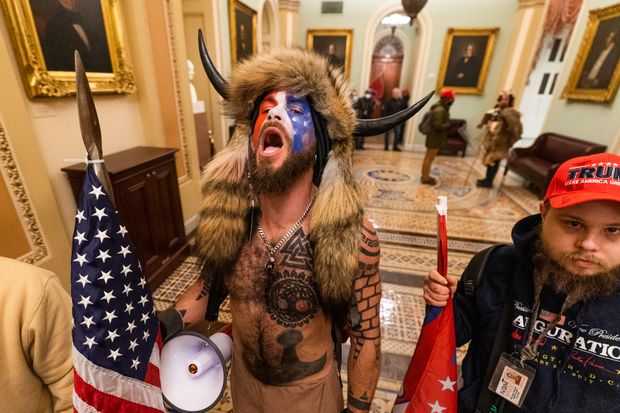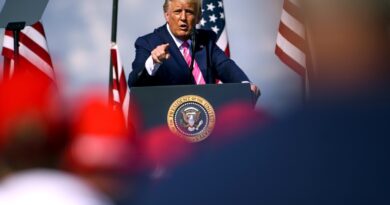What Is QAnon? What We Know About the Conspiracy-Theory Group
The conspiracy-theory group known as QAnon has grown in popularity in recent months. It has spread from fringe internet message boards to mainstream platforms and has become a political issue, and on Jan. 6, its adherents were among the most prominent members of the mob of former President Donald Trump’s supporters who stormed the U.S. Capitol in Washington. Here is what we know about QAnon, the conspiracy theory behind it and how it started.
What is QAnon?
QAnon is a far right-wing, loosely organized network and community of believers who embrace a range of unsubstantiated beliefs. These views center on the idea that a cabal of Satan-worshipping pedophiles—mainly consisting of what they see as elitist Democrats, politicians, journalists, entertainment moguls and other institutional figures—have long controlled much of the so-called deep state government, which they say sought to undermine Mr. Trump, mostly with aid of media and entertainment outlets.
What is the QAnon conspiracy theory?
QAnon conspiracy theory alleges that there is a battle between good and evil in which the Republican Mr. Trump is allied with the former. QAnon followers are awaiting two major events: the Storm and the Great Awakening. The Storm is the mass arrest of people in high-power positions who will face a long-awaited reckoning. The Great Awakening involves a single event in which everyone will attain the epiphany that QAnon theory was accurate the whole time. This realization will allow society to enter an age of utopia.
Who is “Q”?
Followers believe that “Q” is a high-ranking government insider, presumably with a military or intelligence background, committed to exposing the hidden truth of what they see as an international bureaucracy scheming against Mr. Trump and his supporters. Some followers believe that “Q” often sends coded signals about his or her existence, using the number 17—the letter Q’s placement in the alphabet. Online posts surrounding QAnon conspiracy theories have often described “Q” as a patriot or saint.
What role did QAnon and its adherents play in the storming of the Capitol?
QAnon and its adherents were instrumental in Mr. Trump’s drive to overturn the November election, which he lost decisively. In November, Sidney Powell, a former federal prosecutor who was then representing Mr. Trump, said on Fox Business that she would “release the kraken,” a reference to a powerful mythical beast, by making public evidence of widespread voter fraud. Neither Ms. Powell nor any of Mr. Trump’s supporters have done so, but QAnon supporters adopted the phrase as a rallying cry.
QAnon apparel was prevalent throughout the crowd at the Capitol and surrounding it. During the storming of the Capitol, one of the first people up the stairs leading to the Senate chamber was a man who wore a QAnon T-shirt.
What was the reaction to President Biden’s inauguration?
QAnon message boards lit up during the inauguration with mixed messages.
Many people who were anticipating the Great Awakening were disappointed when it didn’t transpire. Some struggled with what to make of the new administration.
But others like Ron Watkins, a prominent QAnon supporter, appeared ready to move on.
“We gave it our all,” Mr. Watkins wrote on Telegram. “Now we need to keep our chins up and go back to our lives as best [as] we are able. We have a new president sworn in and it is our responsibility as citizens to respect the Constitution. As we enter into the next administration please remember all the friends and happy memories we made together over the past few years.”

QAnon adherent Jake Angeli reached the Senate chamber inside the Capitol on Jan. 6.
Photo: Manuel Balce Ceneta/Associated Press
Who is Jake Angeli ?
QAnon adherent Jacob Anthony Chansley, also known as Jake Angeli, was among the most visible members of the throng that breached the Capitol, reaching the Senate chamber and briefly occupying the seat just vacated by Vice President Mike Pence, according to photographs taken at the scene. Mr. Chansley was shirtless and wearing his trademark fur hat and bison horns, his tattoos on display.
An Arizona native, Mr. Chansley has espoused QAnon views outside the Arizona Capitol since at least 2019, according to the Arizona Republic newspaper. He has often carried a battered sign reading: “Q sent me.”
“The snowball has been rolling and it’s only getting bigger,” Mr. Chansley told the newspaper in February outside a Trump rally in Phoenix. “We’re the mainstream now.”
Mr. Chansley was arrested on Jan. 9 on federal charges connected to breaking into the Capitol building. The Capitol Police investigator noted in court documents that after viewing news-media photographs of the attack on the Capitol, he identified Mr. Chansley in part based on his “unique attire and extensive tattoos.”
Who is Marjorie Taylor Greene ?
Rep. Marjorie Taylor Greene, a Georgia freshman Republican, is a Trump loyalist who has in the past embraced the QAnon conspiracy theory and made venomous comments about Muslims and other groups. She also cast doubt on whether some school shootings actually happened and questioned whether a plane crashed into the Pentagon on Sept. 11, 2001. She spoke at a “Stop the Steal” rally a day before the Jan. 6 attack on the Capitol and has said Mr. Trump bears no responsibility for the riot, and has protested rules requiring members of Congress to wear masks in the Capitol complex. Mrs. Greene distanced herself from QAnon before she won election in November, and in a speech on the House floor Feb. 4, said she regretted social media posts she wrote about QAnon.
Mrs. Greene has been condemned by lawmakers on both sides of the aisle including Senate Republican Leader Mitch McConnell. On Feb. 4 the House voted 230-199 to strip Mrs. Greene of her committee assignments, with 11 Republicans siding with Democrats. The move will diminish Mrs. Greene’s ability to shape legislation and work with other lawmakers, sidelining her just weeks into her first term in office.
Where and how did QAnon start?
In October 2017, messages on the anonymous online messaging board 4chan attributed to “Q Clearance Patriot” were posted and signed by a user identified as “Q,” referencing the Energy Department’s highest level of security clearance for nuclear weapons, or “Q clearance.” These cryptic messages would later be referred to as “Q drops” or “breadcrumbs,” purportedly clandestine code that often made their way into pro-Trump slogans and messages and were repeated by followers.
The previous year, a man armed with an assault-style rifle fired one or more shots inside Comet Ping Pong, a Washington, D.C., pizza restaurant, and was later arrested. Before the shooting, Trump supporters and white supremacists on social media spread a false conspiracy theory asserting that Hillary Clinton and her former campaign chairman, John Podesta, ran a child sex ring in the basement of a pizzeria. (Comet Ping Pong had no basement.) The shooting has since been considered a precursor to QAnon.
How popular is QAnon?
A new analysis finds that groups perpetuating QAnon conspiracy theory have increased in popularity on Facebook and Instagram since the start of the coronavirus pandemic as more people have spent more time at home and in front of screens. One Facebook group known as “QAnon News & Updates-Intel drops, breadcrumbs, & the war against the Cabal” increased its membership by more than 10 times from Jan. 1 to Aug. 1 of this year.
What are Facebook, YouTube, Twitter and Amazon doing to address QAnon?
Twitter Inc. said on Jan. 11 that it had removed more than 70,000 accounts that spread the QAnon conspiracy theory.
Amazon.com Inc. also said it was removing some products related to the QAnon conspiracy, which has been labeled by the Federal Bureau of Investigation as a domestic terrorist threat.
Facebook said in early October that it would remove more groups and pages devoted to QAnon. The move builds on the social-media company’s efforts announced in August to remove QAnon pages and groups that included discussions of potential violence. The company will now ban any pages or groups dedicated to QAnon across Facebook, as well as Instagram accounts focused on QAnon content. The new policy doesn’t ban individuals from posting about the movement.
In mid-October, YouTube took action against QAnon, banning videos that call for violence. YouTube—a unit of Google—said in a blog post that it would immediately “prohibit content that targets an individual or group with conspiracy theories that have been used to justify real-world violence.” The development puts Google and parent Alphabet Inc. further into an area the conglomerate has sought to avoid: the outright removal of content.
Is QAnon dangerous?
A memo the FBI released in May identified QAnon as a potential domestic terrorism threat, citing at least two incidents connecting QAnon with the planning and execution of violent acts.
Write to Brett Forrest at brett.forrest@wsj.com
Copyright ©2020 Dow Jones & Company, Inc. All Rights Reserved. 87990cbe856818d5eddac44c7b1cdeb8
*** This article has been archived for your research. The original version from The Wall Street Journal can be found here ***


